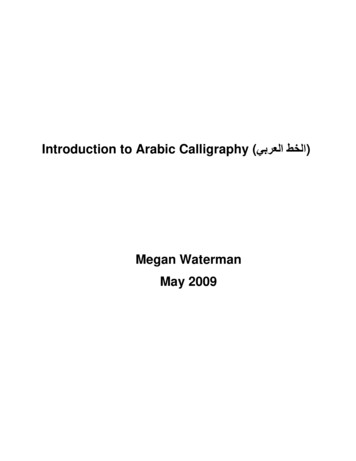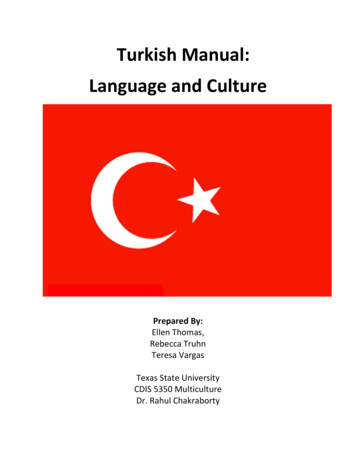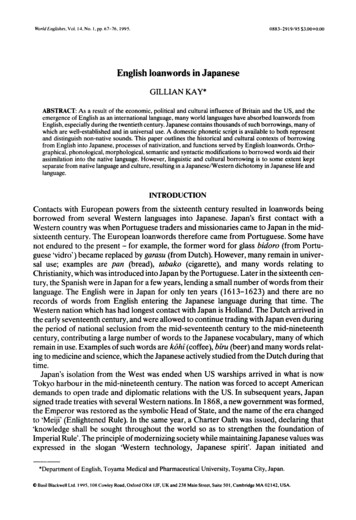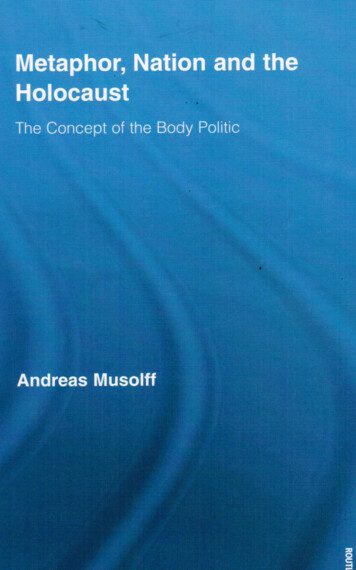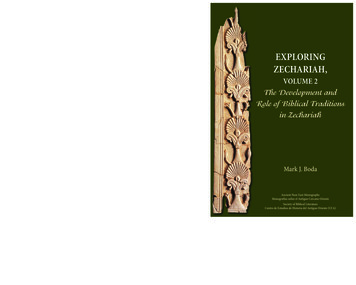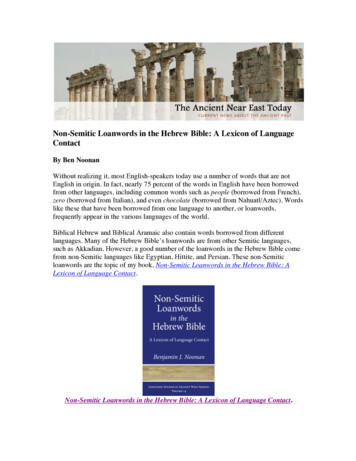
Transcription
!Non-Semitic Loanwords in the Hebrew Bible: A Lexicon of LanguageContactBy Ben NoonanWithout realizing it, most English-speakers today use a number of words that are notEnglish in origin. In fact, nearly 75 percent of the words in English have been borrowedfrom other languages, including common words such as people (borrowed from French),zero (borrowed from Italian), and even chocolate (borrowed from Nahuatl/Aztec). Wordslike these that have been borrowed from one language to another, or loanwords,frequently appear in the various languages of the world.Biblical Hebrew and Biblical Aramaic also contain words borrowed from differentlanguages. Many of the Hebrew Bible’s loanwords are from other Semitic languages,such as Akkadian. However, a good number of the loanwords in the Hebrew Bible comefrom non-Semitic languages like Egyptian, Hittite, and Persian. These non-Semiticloanwords are the topic of my book, Non-Semitic Loanwords in the Hebrew Bible: ALexicon of Language Contact.Non-Semitic Loanwords in the Hebrew Bible: A Lexicon of Language Contact.
In many cases, we can identify with relative certainty the specific language that a nonSemitic loanword comes from. An excellent example is the Hebrew word פַּרְ עֹה ‘pharaoh’. This word comes from Egyptian pr-ʿꜢ, which originally referred to theEgyptian ruler’s ‘great house’ but eventually came to be used as a title for the rulerhimself. Because this word designates an Egyptian ruler and therefore a concept foreignto ancient Israel, Hebrew speakers had no native word to refer to it. So, they adopted theEgyptian word for ‘pharaoh’ into Hebrew. Other good examples of words in Hebrew thathave an Egyptian origin are ‘ חוֹתָ ם seal, signet ring’ (borrowed from Egyptian ḫtm) and ‘ ףסוּ reed, rush plant’ (borrowed from Egyptian ṯwf).Statue of Pharaoh Ramesses II, Luxor Temple. (Wikimedia Commons)
Scaraboid Seals. (Bible and Orient Museum, Fribourg/Wikimedia Commons)Papyrus Sedge Plant (Cyperus papyrus). (Wikimedia Commons)In other instances, we know that a word is not original to Hebrew or the Semiticlanguages but cannot identify its specific source. For example, the Hebrewword0ִ ‘ ןיַי wine’ has no native etymology in either Hebrew or any of the other Semiticlanguages, indicating that it is not original to them. Furthermore, related words occur inmany non-Semitic languages, such as Greek οἶνος, Latin vinum, and Georgian ġvino.Scholars continue to debate the origin of all these terms, and a convincing etymology hasyet to be offered. Thus, Hebrew י ַי ִן and all these related words are representative of anancient culture word, or word of unknown origin.
First Century CE Wine Press, Old City of Jerusalem. (Wikimedia Commons)In my book I present a comprehensive listing of the Hebrew Bible’s 235 non-Semiticloanwords. Of these 235 loanwords, I identify 150 words that were borrowed directlyfrom a non-Semitic language into either Hebrew or Aramaic. The vast majority (135) ofthese non-Semitic loanwords come from Egyptian, Greek, Hittite, Luvian, Hurrian, OldIndic, or Old Iranian. The remainder (15) come from other less well-known languageslike Philistine.The distribution of these non-Semitic loanwords is summarized in the following table.Numbers represent raw counts, and percentages in parentheses represent the ratio ofloanwords to the total number of words for each category. (Keep in mind that somewords are found in more than one canonical division, which is why the sum of thenumbers in the canonical divisions doesn’t equal the total number in each category.)Hittite/!Old!Old!!All!Egyptian! Greek!Hurrian!Other!LuvianIndic! Iranian!Entire!Hebrew!Bible!150!54!(1.78%) (0.64%)8!6!11!4!52!15!(0.09%) (0.07%) (0.13%) (0.05%) (0.62%) (0.18%)Torah!43!30!(1.30%) (0.91%)0!4!4!0!0!5!(0.00%) (0.12%) (0.12%) (0.00%) (0.00%) (0.15%)31!14!(0.95%) (0.43%)0!3!9!0!1!4!(0.00%) (0.09%) (0.28%) (0.00%) (0.03%) (0.00%)59!35!(1.47%) (0.87%)1!6!10!1!1!5!(0.02%) (0.25%) (0.25%) (0.02%) (0.02%) (0.12%)106!23!(1.83%) (0.40%)7!3!8!4!50!11!(0.02%) (0.05%) (0.14%) (0.07%) (0.86%) (0.19%)Former!Prophets!Latter!Prophets!Writings!
The above data, combined with the other data surfaced by my study, reveal someinteresting patterns in the Hebrew Bible’s distribution of loanwords. These patternsinclude the following:The two most common donor languages are Egyptian and Old Iranian, but wordsfrom these languages are concentrated in certain places. Egyptian terminologyparticularly appears in the Joseph Cycle (Genesis 37–50) and the book of Exodus.The vast majority of Old Iranian loanwords appear in the books of Esther, Daniel,and Ezra. ! In general, the Hebrew Bible’s source-critical divisions do not possess adistinctive loanword vocabulary. Thus, whereas vocabulary has played asignificant role historically in the practice of source criticism, non-Semiticloanwords can offer little help in this regard. ! The distribution of non-Semitic loanwords roughly corresponds to the date of theindividual books’ composition. On the one hand, the number of Egyptian, Hittiteand Luvian, and Hurrian loans is greater in texts traditionally attributed to earlierperiods. On the other hand, the number of Greek, Old Indic, and Old Iranianloanwords is greater in texts traditionally attributed to later periods. ! Almost all the foreign loanwords (approximately 96%) in the Hebrew Bible arenouns. This pattern reflects the cross-linguistic tendency for nouns to be borrowedmore frequently than other parts of speech. It also indicates that the HebrewBible’s non-Semitic loanwords are primarily cultural (rather than core) terms. !In addition to surfacing interesting patterns like these, investigation of the HebrewBible’s non-Semitic loanwords enhances our understanding the Hebrew Bible and theworld in which it was written in at least several other ways.First, analysis of the Hebrew Bible’s non-Semitic terminology leads to a betterunderstanding of the biblical text. Knowledge of a loanword’s origin can help clarify itsmeaning and the connotations associated with that word. Because the meaning of thebiblical text depends in part on the meaning of its individual words, the study of nonSemitic terminology ultimately leads to better translation and exegesis of the biblical text.Second, exploration of the non-Semitic vocabulary in the Hebrew Bible enhances ourknowledge of both the biblical languages and the ancient Near East’s non-Semiticlanguages. We see how foreign sounds were perceived by speakers of Hebrew andAramaic and how those individuals treated foreign words linguistically. This providessignificant insight into the phonology, orthography, and morphology of the languages ofthe ancient Near East.Third, study of the Hebrew Bible’s non-Semitic loanwords informs our knowledge ofcontact between Hebrew and Aramaic speakers and the speakers of non-Semiticlanguages. While loanwords can sometimes serve rhetorical purposes, most often directborrowings reflect historical interactions between different cultures. The presence of non-
Semitic terminology in the Hebrew Bible therefore provides insight into the historicalrelationships between the ancient Israelites and non-Semitic people groups.In sum, the Hebrew Bible’s loanwords represent a fascinating topic of study. Analysis ofthese loanwords’ origins and distribution sheds significant light on the Hebrew Bible andthe world in which it was written. By doing so, we gain a better understanding of thelinguistic and historical contact between the ancient Israelites and non-Semitic peoplessuch as the Egyptians, Hittites, and Persians.Benjamin J. Noonan is Associate Professor of Old Testament & Hebrew at ColumbiaInternational University (Columbia, SC).
Biblical Hebrew and Biblical Aramaic also contain words borrowed from different languages. Many of the Hebrew Bible’s loanwords are from other Semitic languages, such as Akkadian. However, a good number of the loanwords in the Hebrew Bible come from non-Semitic languag

